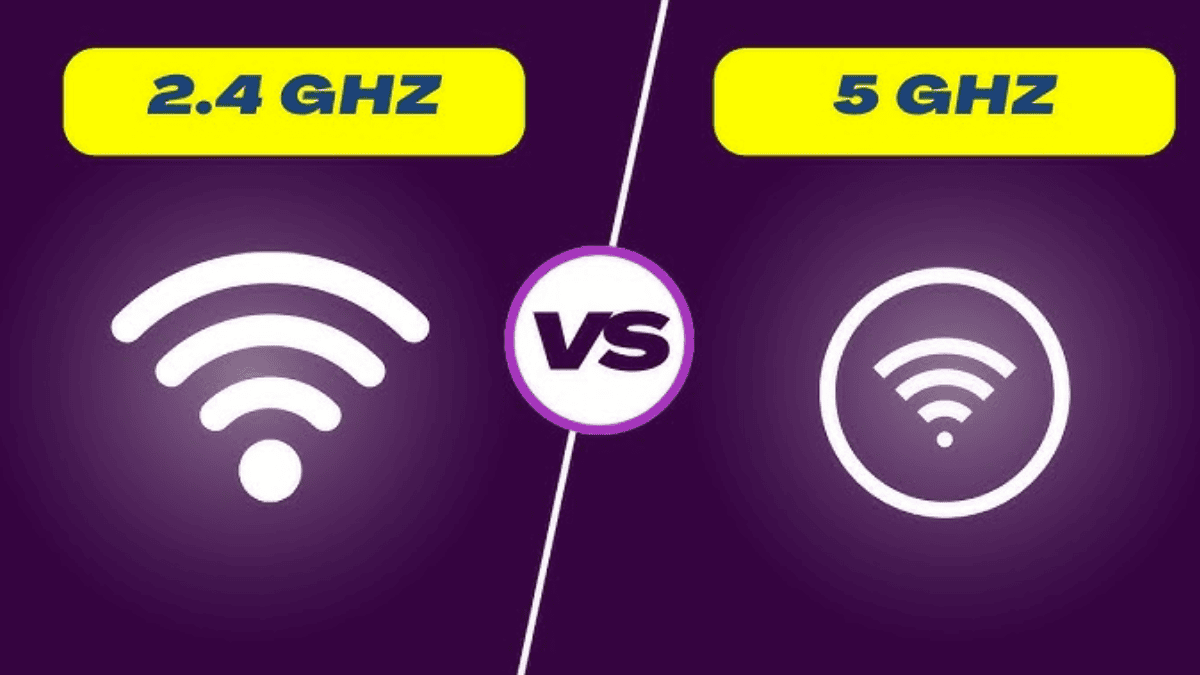Wi-Fi technology has become an essential part of our daily lives, connecting devices to the internet and facilitating communication, entertainment, and work. However, not everyone understands the fundamental differences between the two main frequency bands used for Wi-Fi: 2.4GHz and 5GHz. Both bands are part of the radio frequency spectrum, but they operate in different ways, which can affect performance in various situations, especially when it comes to IT support in troubleshooting connection issues.
In this article, we will explore the differences between 2.4GHz and 5GHz Wi-Fi frequencies, examining their characteristics, advantages, disadvantages, and how each can be best utilized depending on your specific needs.

What is 2.4GHz Wi-Fi?
The 2.4GHz band has been the standard for Wi-Fi communications for many years. Operating at a frequency of 2.4 gigahertz, this band offers a broader range of coverage compared to its counterpart, the 5GHz band. Because 2.4GHz signals travel further and penetrate walls and obstacles more effectively, it is an ideal choice for large homes or buildings with several rooms or floors.
This frequency band is not only used for Wi-Fi but also shared by a wide variety of other devices, such as microwaves, Bluetooth devices, baby monitors, and more. The fact that so many devices operate on the 2.4GHz band can sometimes cause interference, affecting Wi-Fi performance.
3 Advantages of 2.4GHz Wi-Fi
- Longer Range: The 2.4GHz band has a greater range and can cover larger areas, making it ideal for homes with multiple rooms or spaces that need to be covered.
- Better Penetration: This frequency band works well in environments with walls, floors, and other physical obstructions that might block Wi-Fi signals.
- Lower Cost: Many older routers and devices use the 2.4GHz band, and generally, equipment supporting this frequency tends to be more affordable.
3 Disadvantages of 2.4GHz Wi-Fi
- Congestion: Because many devices use this frequency, the 2.4GHz band is prone to interference. This can cause slower speeds or unstable connections, especially in dense areas like apartment buildings.
- Lower Speeds: The 2.4GHz band supports lower data transfer speeds compared to the 5GHz band. This makes it less suitable for tasks that require high-speed internet, such as streaming HD video or gaming.
- Crowded Spectrum: Since the 2.4GHz band is shared with various other devices, it’s common to experience congestion, which could negatively impact performance.
What is 5GHz Wi-Fi?
The 5GHz Wi-Fi band was introduced as a way to address the limitations of 2.4GHz Wi-Fi. Operating at a frequency of 5 gigahertz, it offers a much faster data transfer rate and lower interference due to the reduced number of devices using the band. While 5GHz signals are better for high-speed applications like streaming, gaming, and large file transfers, their shorter range and inability to penetrate walls as effectively as 2.4GHz can be limiting in certain situations.
Many modern routers now offer dual-band technology, meaning they can broadcast both 2.4GHz and 5GHz signals simultaneously. This allows users to switch between the two frequencies based on their needs.
3 Advantages of 5GHz Wi-Fi
- Higher Speeds: The 5GHz band supports faster data transfer rates, making it a better choice for activities like online gaming, streaming 4K video, and video conferencing.
- Less Interference: Since fewer devices use the 5GHz band, there is generally less interference from other electronics, leading to a more stable connection.
- More Channels: The 5GHz band has more channels available for use, reducing congestion in areas with many Wi-Fi networks, such as apartment complexes.
3 Disadvantages of 5GHz Wi-Fi
- Shorter Range: While 5GHz Wi-Fi offers higher speeds, its signals do not travel as far as 2.4GHz signals. This can be a disadvantage in larger homes or areas with multiple floors.
- Poorer Penetration: 5GHz signals are less effective at penetrating walls and other obstacles. If your router is located far from the area where you need Wi-Fi, you may experience weaker signals or slower speeds.
- Device Compatibility: Not all devices support 5GHz Wi-Fi, especially older ones. If you're using older equipment, you may not be able to take advantage of the benefits of the 5GHz band.
4 Key Differences Between 2.4GHz and 5GHz Wi-Fi
Deciding between 2.4GHz and 5GHz Wi-Fi requires an understanding of the key differences in how each band affects your network experience. The choice between these two frequencies can impact everything from speed to coverage, and even device compatibility. Here’s a breakdown of four important factors to consider:
Speed and Performance
The 5GHz band offers faster speeds than 2.4GHz, which is essential for high-bandwidth applications like video streaming, gaming, or large file transfers. 5GHz Wi-Fi can support data rates of up to 1.3 Gbps (gigabits per second), while 2.4GHz typically supports speeds of up to 450-600 Mbps (megabits per second).
However, 2.4GHz signals provide better coverage over larger areas, meaning if you're farther from your router, you may experience better performance on 2.4GHz despite its slower speed.
Range and Coverage
2.4GHz Wi-Fi has a longer range than 5GHz. This means that in larger homes or multi-story buildings, 2.4GHz will likely provide a stronger and more stable connection, especially through walls and other obstructions.
5GHz, on the other hand, has a shorter range, which can be problematic if you're located far from your router or have multiple floors. The higher frequency of 5GHz signals makes them less effective at passing through solid objects, leading to weaker signals in areas far from the router.
Interference and Congestion
2.4GHz is more prone to interference because it shares its frequency with other devices like Bluetooth, microwaves, and baby monitors. In densely populated areas, this can cause significant slowdowns and dropped connections.
5GHz has much less interference, as fewer devices operate within this frequency range. This makes it ideal for busy environments or situations where multiple people are using Wi-Fi at once.
Device Compatibility
Older devices, such as legacy laptops or smartphones, may not support 5GHz Wi-Fi. In these cases, the 2.4GHz band remains the only option. Newer devices, however, often support both 2.4GHz and 5GHz, allowing users to switch between the two depending on their needs.
Choosing the Right Frequency for Your Needs
Selecting the right Wi-Fi frequency for your needs involves considering factors such as coverage area, device compatibility, and the activities you plan to perform. Both 2.4GHz and 5GHz offer distinct advantages depending on your situation. Below is a breakdown to help you determine when each frequency might be the best choice:
When to Use 2.4GHz Wi-Fi
- Larger Coverage Areas: If you have a large house or need Wi-Fi to cover multiple rooms or floors, 2.4GHz is a better choice.
- Less Interference in Low-Device Areas: In places with fewer competing devices, such as rural areas, the 2.4GHz band may be sufficient for your needs.
- Older Devices: If you're using older devices that only support 2.4GHz, this frequency will be your only option.
When to Use 5GHz Wi-Fi
- High-Speed Activities: If you're gaming, streaming HD or 4K video, or performing tasks that require a lot of bandwidth, 5GHz is the ideal choice.
- Reduced Interference: If you're in an area with many competing Wi-Fi networks or other electronics that interfere with the 2.4GHz band, 5GHz offers a cleaner, less congested signal.
- Smaller Spaces: If your home or office is small and doesn't have too many walls between the router and your devices, 5GHz will give you better performance.
Which Band is Best for You?
Ultimately, whether 2.4GHz or 5GHz is better for you depends on your specific needs. If you prioritize range and coverage in a larger space, 2.4GHz might be the better option. However, if you're focused on speed and performance for tasks like gaming, streaming, or using multiple devices simultaneously, 5GHz is likely the right choice.

Stay Future-Ready with LK Tech
For optimal performance, I recommend using a dual-band router that supports both 2.4GHz and 5GHz frequencies. By doing so, you can easily switch between bands depending on your needs, ensuring smooth and reliable connectivity. Whether you're working, streaming, or gaming, each band offers distinct advantages that can improve your experience. If you're in the Cincinnati area and need expert guidance, LK Tech, one of the leading Cincinnati IT companies, is here to offer tailored IT support services. We provide top-notch solutions designed to meet your specific needs. Contact us today to learn more about how we can enhance your network and IT infrastructure.


